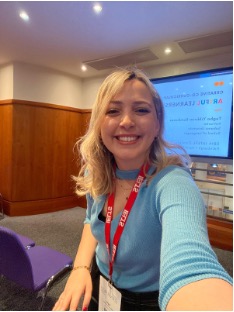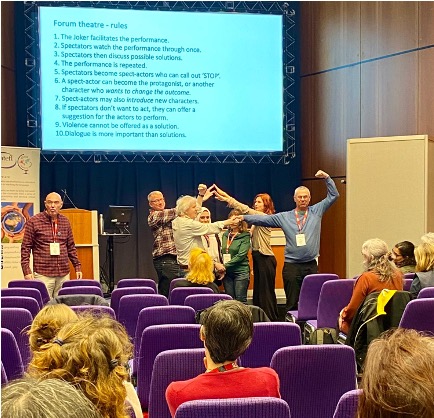
Reflections from IATEFL 2025
Tugba Yıldırım Kumbasar
The IATEFL Conference, held from 7 to 11 April 2025 in Edinburgh, offered a wide array of inspiring and intellectually stimulating sessions, making it a delightful challenge to experience everything and capture it all in a single post. With that in mind, I’ve chosen to reflect on a few sessions that particularly resonated with my focus on arts in language education, and to consider how their insights can be meaningfully applied within our specific second language (SL) teaching context.
I attended the IATEFL Conference to present a session titled "Creative Co-curricular: Artful Learners' Club”, a project I previously carried out with R3, R4, and R4 Intensive students. Over the course of four weeks, we held weekly 90-minute sessions where students created artwork through language use, culminating in an online exhibition of their work—which you can still view via this link. In my session, I explained how my previous arts-integration practices were mostly limited to classroom teaching, and how this project was my first attempt to move beyond that, creating an artful learning environment outside the regular curriculum. The literature highlights two common challenges in arts integration: a rigid curriculum that leaves little room for creative work, and the varying levels of student interest in art. This project aimed to address both by supplementing language learning through co-curricular, art-based activities. I walked the audience through the project’s aims, the process, and the specific art-integrated activities involved, and we wrapped up with a discussion on how this model could be adapted in other contexts. The questions I received mainly focused on how much time was needed to prepare the materials and how I promoted the project.
One standout session I attended centered on the work of two influential thinkers who have profoundly shaped my educational philosophy: Paulo Freire and Augusto Boal. Freire is renowned for his pioneering contributions to critical pedagogy, while Boal, drawing inspiration from Freire, developed Theatre of the Oppressed, a practice grounded in dialogue, participation, and empowerment through performance. In this practice, we see how Freire’s idea of balancing teacher and learner in the classroom is realized through Boal’s Forum Theatre, where the voices of both actors and spectators are balanced, giving the audience an active role (spect-actors) in shaping the performance.
Titled “Transformative Theatre in Teacher Education: Moving from Spectators to Spect-actors”, the session was facilitated by Rose Aylett and introduced participants to classroom application of Boal’s Forum Theatre. We began with several engaging warm-up activities, including “Names and Gestures”, “Good Day”, and “Sculptures”. These exercises helped build group cohesion and prepare us for the collaborative work ahead. From there, we explored the core structure of forum theatre, with participants taking on the defined roles of:
● Protagonist: representing the oppressed
● Antagonist: representing the oppressor
● Supporting Characters: other figures in the scene
● Joker: the facilitator or guide
● Spectators: audience members
● Spect-actors: audience members who step into the performance to interact with the story

After reviewing the foundational rules (slide in the photo below), we broke into small groups to develop and perform two short scenes. Each performance unfolded in two phases:
1. Initial Performance: the scene played out as rehearsed.
2. Interactive Performance: audience members could intervene by calling out, “STOP!” to suggest changes, take on a role, or introduce a new character to reshape the outcome.
Personally, this experience echoed earlier engagements I’ve had with performance-based pedagogy. As a student, I first explored these practices in Patricia Sobral’s Artful Teaching course at Brown University. More recently, during the SLTeDOL AIFLI online course I taught last spring, Burcu Ertürk Kılıç from Boğaziçi University joined us as a guest speaker and facilitated an online adaptation of Forum Theatre, which demonstrated how this could be adopted to virtual learning environments. Having experienced Forum Theatre as a learner, teacher, and now again as a conference participant, I continue to be struck by how adaptable and powerful it is. Each iteration brings a new perspective, depending on the facilitator’s creativity and pedagogical goals; yet the outcomes remain consistent: collaboration, creativity, critical thinking, and a sense of empowerment.
This approach aligns powerfully with the goals of SL teaching, where the emphasis is on creating learner-centered learning environments. With thoughtful planning and adaptation, performance-based strategies like Forum Theatre can serve as effective tools in SL classrooms, as they not only promote language development through purposeful interaction, but also nurture creativity, empathy, and critical reflection. (To explore performance-based practices and other approaches to art-integrated teaching in depth, I highly encourage you to attend the Artful Teaching and Learning sessions, which Patricia Sobral from Brown University will be leading for us here at Sabancı University from May 12–14, 2025.)
The last session that I will share is “Narrative Self-observation: a new teacher research and professional development tool” delivered by Jason Anderson and Jaber Kamali. In recent years, my interest in action research and case study methodology has expanded through arts-based research methodologies. I am particularly drawn to autoethnography and narrative inquiry, and I am eager to explore these approaches both in theory and practice more deeply.
This session showcased a well-developed and thoughtful example of narrative self-observation (NSO) as a research and development tool. They outlined the theoretical foundations of the approach, which are unseen observation, autoethnography, storying, and narrative inquiry. They all align with my growing interest in arts-based methodologies.
During the session, Anderson and Kamali shared detailed guidance on the NSO framework, outlining each stage clearly for anyone interested in implementing it. The process begins with the teacher narrating the backstory, either in writing or through discussion with the collaborator. This is followed by meetings to determine the observation focus, preparation of a narrative lesson plan, and a pre-lesson discussion of goals and expectations. After teaching the lesson, the teacher engages in post-lesson self-recall, possibly complemented by a focus group discussion with students to enrich the narrative. The teacher then drafts a reflective lesson story, shares it with the collaborator for feedback, and finally concludes the cycle by compiling all reflections and insights into a comprehensive story, including future considerations.
I see real potential in this process to prompt deep reflection about lesson planning, delivery, and the thinking behind our teaching decisions. Having a collaborator involved throughout offers a supportive structure for reviewing ideas, gaining confidence, and uncovering new perspectives. I especially appreciated the option to include student voices through focus groups, which struck me as a powerful way to deepen my understanding of how a lesson was experienced and what it meant from the learner’s end. Most of all, I love the flexibility the NSO framework provides. The emphasis on storytelling and self-expression offers an artful, human dimension to reflection that I find very motivating. It gives teachers the space to be themselves while developing professionally, which is something I believe is essential.
I believe narrative self-observation can offer an applicable alternative to the developmental observations we currently use in SL, especially in cases where we seek meaningful observation opportunities but lack the time or logistics for having an in-class observer. What I find particularly appealing is that, even without a physical observation, the NSO framework still includes a collaborator who engages with the teacher at different stages of the cycle. This preserves the reflective dialogue and developmental support that traditional observations aim to provide. However, I’m more inclined to use this as a supplementary tool within the observation cycle for now, rather than a complete replacement, as it offers a reflective layer that may enrich our existing practice.
In conclusion, the sessions I have highlighted above were especially powerful in showing how the arts can be meaningfully integrated into our pedagogy not only to support our students’ learning, but also to nurture our own growth as educators. The IATEFL conference itself revealed just how vast and vibrant our global community of educators truly is. It was inspiring to experience the genuine spirit of collaboration throughout, reminding me that we are all part of a collective effort to enrich teaching and learning.
